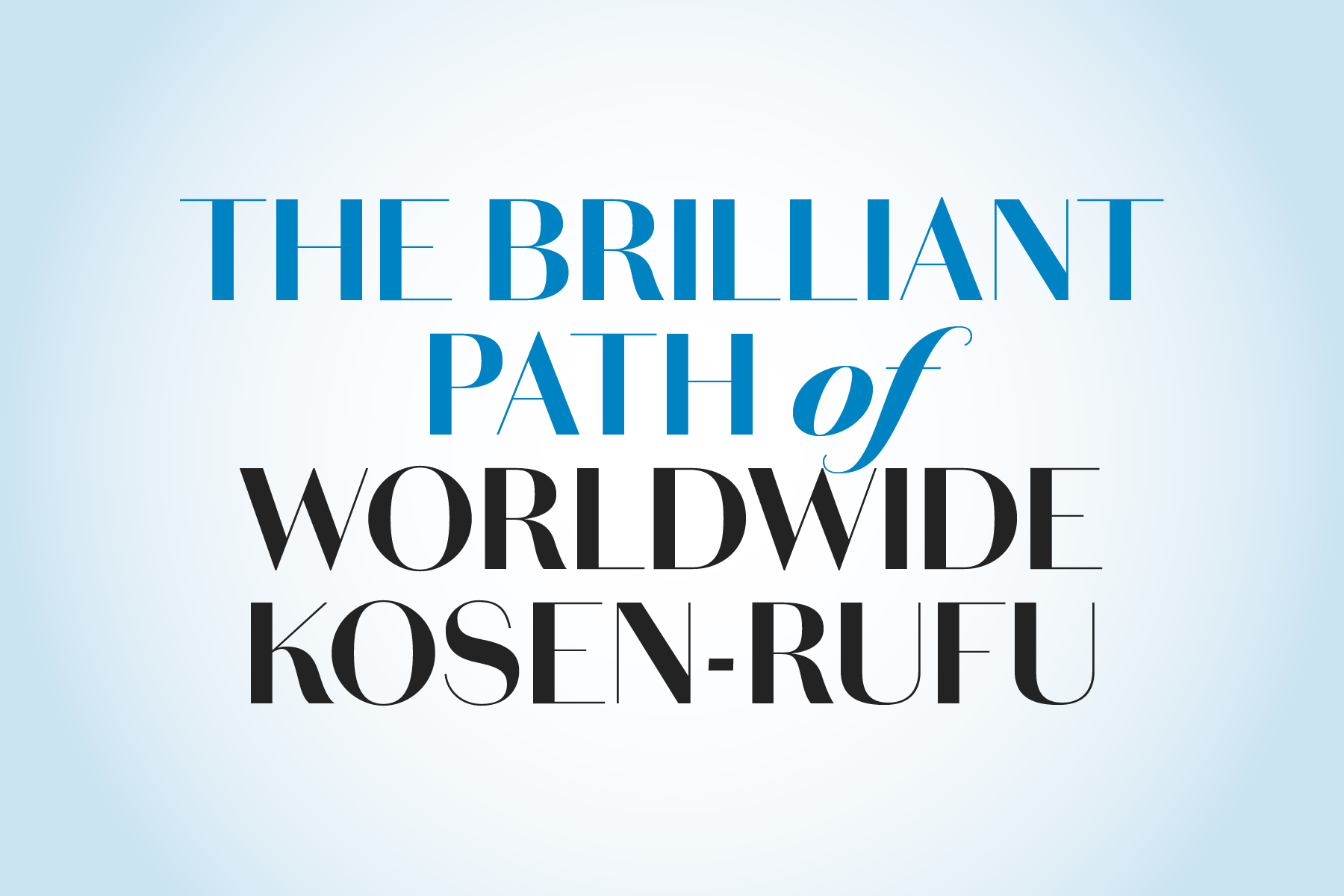This month we will study selected excerpts from The New Human Revolution that were originally published in the December 2, 9, 16 and 23 issues of the Seikyo Shimbun, the Soka Gakkai’s daily newspaper.
Each of Us Is a Protagonist
“The great river of kosen-rufu began with just one person—Nichiren Daishonin. Likewise, the Soka Gakkai started with President [Tsunesaburo] Makiguchi and President [Josei] Toda. But today, our organization has expanded into the world. Though the organization in Europe is still small … you are certain to see tremendous growth.
“This, however, means that each of you must strive with a stand-alone spirit, without being dependent on one another. Everything rests on how many people summon forth lionlike courage and forge ahead with the resolve that they will be victorious without fail and realize kosen-rufu, even if they have to do it alone.
“The accumulation of each person’s determination and each person’s triumph leads to great victory. It thus follows that ushering in a new era and creating history are not extraordinary feats. They simply require that each person challenge his or her own personal objectives and win each day. It all comes down to what action we take right now.
“I hope that you will awaken to your role as protagonists of kosen-rufu and, as champions of faith, enact a bold drama of surmounting difficulties on the grand stage of life.” (The New Human Revolution, vol. 12, revised edition, pp. 48–49)
Leaders Take the Initiative
Spiritual inspiration is a force for victory. We must ignite the life force of others with our own burning life force. …
Shin’ichi’s vibrant initiative thus inspired the entire membership and produced any number of “Shin’ichi Yamamotos” striving at his side.
People are motivated by a feeling of mutual understanding and empathy. Timid, devious leaders who fail to take the initiative cannot get anyone to follow them, no matter what they do. Such leaders become desperate and often resort to authoritarian or domineering words and actions. Then the organization becomes oppressive and unpleasant, and the members are even more alienated.
In contrast, leaders who take the initiative can inspire others through their example, motivate members to act, and awaken in them a sense of empowerment and resourcefulness. Organizations with leaders of this type are brimming with joy and positive energy, and they soar onward together to victory, as if riding a powerful updraft. (NHR-23, 207)
One’s Mission in the Present Life
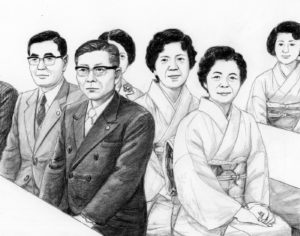
Illustration courtesy of Seikyo Press.
“Nichiren writes, ‘Single-mindedly chant Nam-myoho-renge-kyo and urge others to do the same; that will remain as the only memory of your present life in this human world’ (WND-1, 64). In other words, he declared that dedicating ourselves wholeheartedly to chanting Nam-myoho-renge-kyo and propagating Buddhism will be the most precious memory of this life as a human being.
“We are able to chant and talk to people about Buddhism because we were born as human beings. This means that we have the extremely rare, golden opportunity to attain Buddhahood in this lifetime. Therefore, we need to fulfill our missions in this existence as Bodhisattvas of the Earth.”
Everyone listened to Shin’ichi with serious expressions. …
“This period of putting the finishing touches on your life is the time to demonstrate actual proof of your happiness. It’s my sincere hope that you will all be able to confidently say: ‘I couldn’t possibly be any happier. No life could be more enjoyable or wonderful.’” (NHR-25, 130–31)
A Good Omen
Shin’ichi Yamamoto … read a passage from Nichiren’s writing “Great Evil and Great Good”: “When great evil occurs, great good follows. Since great slander already exists in our land, the great correct Law will spread without fail” (WND-1, 1119). With firm conviction, he then said: “Nichiren lived in a time of upheaval and turmoil—a time racked by major earthquakes, internal strife and the invasion of Japan by the Mongol forces. Despite all this, however, he declared that it was not a time to be pessimistic, for it was in such an age that great good in the form of the widespread propagation of Buddhism would occur.
“We are now advancing kosen-rufu amid the worst economic crisis this country has faced since the end of World War II. Undoubtedly, many of you are experiencing indescribable hardships. But whatever obstacles may come your way, please have absolute confidence in Nichiren’s conviction that ‘When great evil occurs, great good follows.’ Let’s take this as an opportunity to make spirited and dynamic strides forward in our movement for kosen-rufu!” (NHR-18, 248–49)
The Power of Perseverance
“Always carry out personal guidance with patience and a warm, embracing spirit.
“Say, for example, you visit and encourage one of your members who has stopped coming to meetings. It is unlikely that they will be inspired to make a fresh determination in faith after only one visit.
“You need to call on them from time to time and patiently continue to encourage them. Eventually, your sincerity will reach them and they will come to trust you and want to become active again. Perseverance is vital in offering personal guidance.” …
“When you’ve been able to help someone to stand up in faith, it’s important to follow up with them, perhaps with a phone call or letter, to find out how they’re doing, to see if they’ve overcome their problem and to continue encouraging them.
“When you become a leader, you set out enthusiastically to visit members at their homes and encourage them. If you leave it at that, with just a single visit, however, you haven’t finished the job.” (NHR-27, May 2018 Living Buddhism, p. 51)
Kosen-rufu

Illustration courtesy of Seikyo Press.
“Kosen-rufu is not a finite goal,” [Shin’ichi] said. “Based on the fundamental principle of Buddhism, I don’t think we can regard it as some sort of terminus. … That Nichiren referred to ‘the ten thousand and more years of the Latter Day of the Law’ means that kosen-rufu flows on eternally without ever ceasing. Kosen-rufu is not a destination; it is the journey itself, a process of bringing Buddhism to life within society.” …
If kosen-rufu was the journey itself, then it was a continuous endeavor. That meant that to devote oneself to kosen-rufu was to engage in the struggle forever, and that true happiness and the joy and dynamism of life were to be found therein.
Saying that religion is the foundation of culture and the basis of our humanity, Shin’ichi defined kosen-rufu as a great cultural movement unfolding in the realm of the Mystic Law. (NHR-14, revised edition, 249–50)
Discussion Meetings
The discussion meeting actually begins with the central figure or main organizer offering members encouragement and guidance so that they will attend their local meetings. Such one-to-one interaction enables leaders to hear the members’ wishes and opinions. They can also get to know the members’ strengths and interests, as well as learn about their problems and the benefits they have received through faith. Putting this information to use in planning discussion meetings and getting members involved in them serve to make such activities fulfilling and rewarding for all.
Encouragement following discussion meetings is also very important. Leaders should thank members for attending, praise the comments they made during the meeting, listen to their feedback and invite them to attend the next meeting. Asserting that the success of a discussion meeting comes down to everyone’s unity, Shin’ichi urged not only leaders but all members to take full responsibility for them. …
It is crucial that every participant in a discussion meeting feels as though he or she is the central figure and can talk confidently about the joys of faith and the greatness of Buddhism. (NHR-18, revised edition, 254–56)
Buddhist Dialogue
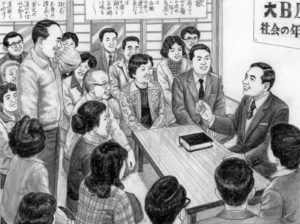
Illustration courtesy of Seikyo Press.
“It’s … crucial that you speak with as many people as possible about the practice. Of course, there is no guarantee that any of them will take faith right away. But what matters is that you continue to tenaciously deepen your bonds of friendship with them, praying every day for their happiness while engaging them in dialogue. If you plant seeds and nurture them with care, they will definitely bloom one day and bear fruit. There’s no need to be impatient.
“In addition, even if your friends haven’t joined the Soka Gakkai, you can still bring them to meetings and study and chant together with them. It’s important to let things happen naturally.
“At any rate, all your efforts to share Nichiren Buddhism will come back to you as good fortune. Whether or not the other person starts to practice, you are still creating causes for your own attainment of Buddhahood. …
“And when someone you’ve been trying to introduce to the practice does decide to become a member, it is truly the most wonderful, joyous feeling.” (NHR-13, revised edition, 156–57)
Facing Adversity
“When you lose your livelihood, the common tendency is to feel depressed, and if you have no apparent future prospects, you can easily become apathetic and despairing.
“If you’re able at such a time to remain filled with life force, energized and ready to face the challenges before you, you can impart tremendous courage to others. Courage spreads with a ripple effect. …
“In many cases, the technical skills and specific experience that you acquired when working in the coal mines will probably not be transferable when you have to change jobs and begin a new occupation. That makes having a vibrant spirit of challenge, vigor, perseverance and optimism all the more important. Companies aren’t interested in hiring people who are negative and apathetic.
“In other words, the tougher the situation, the brighter the “treasures of the heart” will shine in a life that has been rigorously forged. The coal mines may close and the economic situation may be bad, but the treasures of the heart cannot be destroyed. They don’t disappear. And we can build anything with treasures of the heart.” (NHR-25, 73–74)
Basing One’s Life on Nichiren’s Writings
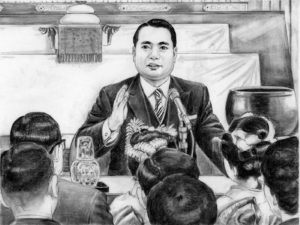
Illustration courtesy of Seikyo Press.
“This next phase of kosen-rufu will be a period of creating a society that upholds such Buddhist principles as compassion and reverence for life.
“In other words, this means the arrival of an age when the Buddhist wisdom that resonates within the Soka Gakkai permeates society and becomes the shared heritage of all humanity. To do that, we must return to the starting point of faith, delving into and reaffirming the ideals of Buddhism, which will serve as the inspiration for building a new society and culture. …
“Making an effort to study Buddhism and fully grasp Buddhist teachings and principles is indispensable for fresh development. This year marks the starting point of our great movement to spread this wonderful life philosophy. Practice without study cannot resonate with or persuade the general public; it is nothing but a practice of self-gratification. Similarly, study without practice remains a mere intellectual game that lacks the power to change the world.” (NHR-17, 3–4)
Setting Goals
“To advance kosenrufu, … it’s always important to have a goal. Without a goal, we become idle and our activities lose their meaning. With a goal, however we will be filled with hope for the future and strength will well forth from our lives. When everyone is determined to meet a set goal no matter what, unity will naturally arise.
“But when leaders lack a spirit of challenge and strong life force, they tend to establish goals that are easy and arbitrary and then try to impose them on the members. Under such circumstances, the members won’t be inspired to do their best. That’s why it’s crucial that leaders themselves are ready to challenge anything and possess the vitality to do so.
“They must also have a tremendous sense of responsibility to achieve the goal even if they have to do it on their own. Such spirit and determination will galvanize the members to take action.” (NHR-9, revised edition, 192)
Stand-Alone Spirit
Ultimately, whether a place achieves peace and prosperity depends solely on the determination of the people who live there. If people lose hope and give up, becoming apathetic and trying to escape from reality, society will degenerate. The key to building a land of happiness lies entirely in the development of human beings. We cannot hope to create such a place by relying on others; it requires each of us rising into action with a stand-alone spirit to work for peace and the happiness of all.
The important thing is to have a philosophy of hope and a strong conviction that can never be compromised, no matter what may happen. It is vital to summon forth the wisdom to blaze a trail through the complicated maze of reality. Nichiren Buddhism is the source of just such wisdom and philosophy. Nichiren Daishonin states, “From this single element of mind spring all the various lands and environmental conditions” (“The Unanimous Declaration by the Buddhas,” WND-2, 843). For this reason, Shin’ichi was resolved to plant the roots of strong and unshakable faith deep in the heart of each member. The construction of a better community and society all comes down to the energy, enthusiasm and wisdom of the people living there. And faith plays a major role in tapping into that power. (NHR-13, revised edition, 260)
Cherry, Peach, Plum and Damson
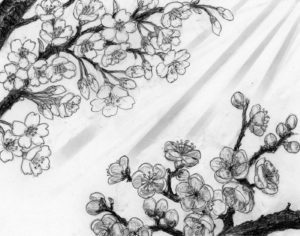
Illustration courtesy of Seikyo Press.
“Second Soka Gakkai President Josei Toda often used the following analogy: ‘Say there’s a river. A river’s width and course don’t change that much. That’s our inherent nature. But a muddy river, whose water is undrinkable, can become perfectly clean and pure. That is the power of faith and human revolution.’
“Your nature is your individuality. It’s what makes you who you are. Nichiren Buddhism enables each of us, in accord with the principle of ‘cherry, plum, peach and damson,’ to make the most of our unique personality and live the best possible life.” …
“A plum tree can’t become a cherry tree, and a cherry tree can’t become a plum tree. The important thing is to shine in a way that is true to yourself. By remaining steadfast in faith, you can bring forth your unique, wonderful self, which no one else can imitate.” (NHR-27, July 2018 Living Buddhism, p. 49)
Taking Initiative
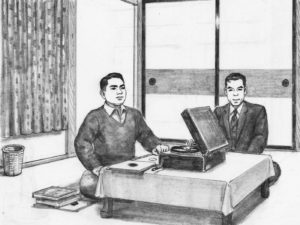
Illustration courtesy of Seikyo Press.
“If you are passive and simply follow instructions, your life will be dull and stagnant. You will be no more than a slave to your circumstances. But if you take the initiative and courageously rise to every challenge you encounter, you are living the life of a champion. Your life condition will soar and you will experience boundless joy.
“Depending on whether you take an active or passive approach, though your day-today activities remain the same, you will feel an enormous difference in your inner commitment and sense of personal fulfillment. And naturally you will see results. As long as you are going to participate in Soka Gakkai activities, I hope you will do so as a leading protagonist, boldly taking action in a way that suits you. …
“Youth is a time of challenge, a time of seeing all your endeavors through to the end without giving up. That’s how you forge and strengthen yourself, build fortune, and achieve great development.
“Let’s give our all to working for kosen-rufu. Let’s struggle together. Let’s devote ourselves fully to our goal. It doesn’t matter if no one else sees your efforts; the Gohonzon knows everything.” (NHR-12, revised edition, 108–09)
Accepting and Understanding
When the purpose of a task is unclear, people cannot give their all. This also applies to activities for kosen-rufu. When the members can accept and understand why a campaign is being conducted—and why at a particular time—they will take action to succeed in that campaign on their own initiative. Their creativity and resourcefulness will be inspired. This is a manifestation of practical hands-on wisdom. And wisdom is the force that mobilizes knowledge. …
If a movement persists in stressing quantitative targets and the means to accomplishing them even though its members do not support its aims and objectives, a sense of coercion will prevail. This saps people’s initiative and enthusiasm; they grow negative about taking action. They lose all their joy and vitality.
When that happens, even the loftiest of movements eventually reaches an impasse. When objectives are understood and agreed upon, however, the next step is to set clear goals. (NHR-2, revised edition, 14–15)
Buddhism Is Win or Lose
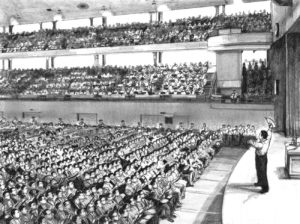
Illustration courtesy of Seikyo Press.
“Nichiren Daishonin writes, ‘Buddhism primarily concerns itself with victory or defeat’ (“The Hero of the World,” WND-1, 835). This is because kosen-rufu is a struggle against the devil king of the sixth heaven, the negative function that destroys life. In fact, human existence is itself a struggle. Realizing genuine happiness begins with challenging and winning over our own cowardice and laziness. Human revolution means to overcome the negative aspects of the self, and our Soka Gakkai activities are the arena in which we can do so.
“I am not really concerned with the short-term results of our propagation activities; what matters most is that each of you exerts yourself wholeheartedly in faith, enjoys great benefit and an enriched life, and attains a boundless state of life overflowing with joy. I hope you will always remember that this is the reason we share Nichiren Buddhism with others and why we engage in Soka Gakkai activities.” (NHR-8, revised edition, 38–39)
Prayer
“It can sometimes seem … that our lives are just a series of hardships and suffering in this world. In such circumstances, the only way to win is through chanting Nam-myoho-renge-kyo. Those with strong faith have the spirit to go to the Gohonzon and chant in any situation. The stronger your determination to persevere in faith, the more certain you are to draw good fortune into your life, just as a magnet draws iron to it. …
“To really experience the power of the Gohonzon, you must make your prayers specific. You might also try setting yourself a personal target of how much to chant each day. Your prayers to the Gohonzon will definitely be answered. When they are, you feel real joy and conviction, which in turn will further strengthen your faith. Even if your prayers aren’t answered immediately, please be assured that you are accumulating inconspicuous benefit and that, with the passage of time, you will attain a life state of complete fulfillment and satisfaction.” (NHR-26, 122–23)
Successors
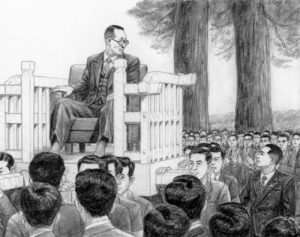
Illustration courtesy of Seikyo Press.
“Just as President Makiguchi passed the baton of kosen-rufu to Mr. Toda, Mr. Toda entrusted everything concerned with kosen-rufu to me and the other youth division members, for the sake of the future. That entrustment took place on March 16, 1958, when six thousand youth members had assembled.
“The next wave of kosen-rufu can be generated only by the youth. And successive generations must increase the size of these waves that expand kosen-rufu. This ongoing effort is what we mean by kosen-rufu.
“There is no future for kosen-rufu or the Soka Gakkai if the youthful successors are timid and weak, unable to create their own generation’s waves to propagate Nichiren Buddhism.
“That’s why I am so intensely involved with fostering the youth division, the high school division, and all members who will inherit the future. We must entrust kosen-rufu to you. I will dedicate myself wholeheartedly to you. I’m prepared to give my very life to you.” (NHR-25, 83–84)
Public Relations
“Let me [share] Mr. Toda’s thoughts on developing good public relations. He regarded it as a top priority, declaring unequivocally that kosen-rufu is an effort to promote understanding for our movement in society. He also said those who cannot foster positive relations should not be given important positions in the organization.
“When Mr. Toda appointed me the first head of the Soka Gakkai’s public relations department, he said: ‘Shin’ichi, developing human relations is vital. I want you to meet with as many people as you can and build friendships with them. Everything will serve as a life lesson and is linked to the development of kosen-rufu.’ In other words, it all comes down to whether, as individuals, we can win the trust and respect of others. That was Mr. Toda’s view of public relations and it is the Soka Gakkai’s as well.” (NHR-18, revised edition, 291–92)
Unity
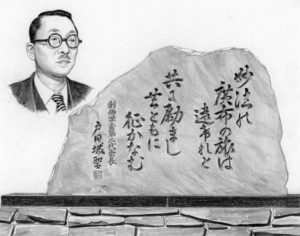
Illustration courtesy of Seikyo Press.
The journey to propagate
the Mystic Law
is long;
Let us encourage each other
and advance together.
President Toda had written it on New Year’s Day 1955. The poem highlights the importance of the bonds between mentor and disciple and among fellow members.
Kosen-rufu cannot be realized without a stand-alone spirit. At the same time, kosen-rufu will not spread without unity, without members encouraging one another and advancing together. President Toda used to refer to the Soka Gakkai—the organization carrying out this noble task—as “Soka Gakkai Buddha.”
As Nichiren Daishonin writes: “All disciples and lay supporters of Nichiren should chant Nam-myoho-renge-kyo with the spirit of many in body but one in mind, transcending all differences among themselves to become as inseparable as fish and the water in which they swim. This spiritual bond is the basis for the universal transmission of the ultimate Law of life and death” (“The Heritage of the Ultimate Law of Life,” WND-1, 217). (NHR-24, 75)
Battling Devilish Functions
“Should you feel stuck, please challenge to overcome your own weakness, summoning the great power of faith. …
“In the long course of our lives, we may occasionally feel like giving up our faith and just having a good time, free from all responsibility. Or we may become ill or be plunged into grief by the death of a loved one. This is our struggle against the hindrances of earthly desires, illness, and death.
“Buddhism’s greatest significance lies in overcoming such impasses by chanting Nam-myoho-renge-kyo, attaining a state of absolute happiness and realizing the most meaningful of lives. Therefore, whenever you encounter a difficulty, I hope you will view it as a struggle against an impasse, as a battle against obstacles and, resolving that now is the time to win, boldly forge your path in life as you challenge your destiny head-on.” (NHR-2, revised edition, 87)
Crisis Prevention
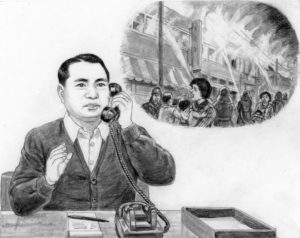
Illustration courtesy of Seikyo Press.
Some people tend to take things for granted. They assume that the present situation will continue unchanged, and since nothing bad has happened so far, they don’t have to worry about what might happen next, even though in actuality some danger may be growing in their midst. In fact, they even forget to think about possible threats and dangers. They stop paying attention to important telltale signs and become careless.
Overcoming that mindset is the first step in preventing accidents. Nichiren Daishonin writes, “A wise person, while dwelling in security, anticipates danger” (“The Problem to Be Pondered Night and Day,” WND-1, 621). Astute people will always be prepared for an emergency, even when the situation seems safe.
With the approach of December, a month in which fires and various other accidents increase in Japan, Shin’ichi decided to take the initiative and check on the Soka Gakkai facilities in the area around the headquarters. (NHR-24, 84–85)
You are reading {{ meterCount }} of {{ meterMax }} free premium articles

